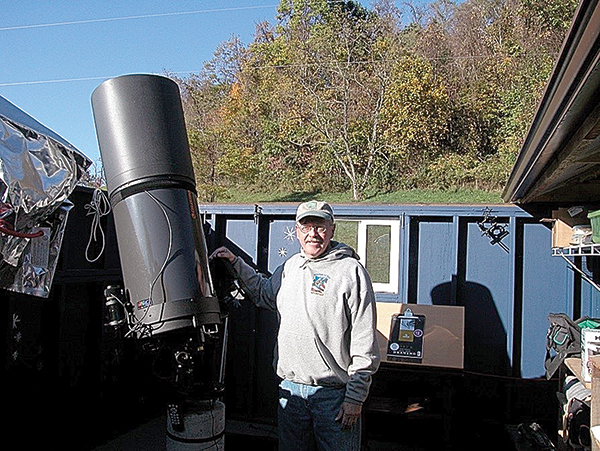
By John C. Dean
Contributing Writer
I recently had the pleasure of talking with three local, amateur astronomers and astrophotographers. They discussed their backgrounds and love for the nighttime world that looms above. If you attend the Second Annual Dark Sky Party at Droop Mountain Tower Friday, September 22, you will get to see their talents on display and speak to them personally, all while taking in the expanse of the universe.
J. Perez, David Buhrman and Michael Rosolina will be assisting the public to view the nighttime skies at this popular celestial event. Perez, Buhrman and Rosolina also helped the Watoga State Park Foundation compile dark sky data for its expansive International Dark Sky application. Official Dark Sky Park status was granted by the International Dark-Sky Association in 2021.
“I am a relative newcomer to the world of astronomy,” Perez said.
He was a software engineer for 40 years until retiring from the National Radio Astronomy Observatory (NRAO) in Charlottesville, Virginia.
“Working for an organization dedicated to astronomy but not having had the visual (and later photographic) experience of our cosmos did not make much sense while working at an observatory,” Perez added.
About 12 years ago, Perez purchased a small telescope and began the process of teaching himself visual astronomy.
“The visual phase did not last very long before I started delving into astrophotography,” he said “Photography had been a hobby of mine since the early 1970s, so it was only natural that I applied the photographic knowledge and skills to my new hobby – astronomy. I am now a full-fledged amateur astrophotographer.”
Buhrman credits his astronomer friend Michael Rosolina with “kindling” his interest in astronomy. But it wasn’t until 1998 that he purchased his first telescope and an introductory book: NightWatch: A Practical Guide to Viewing the Universe.
“Self-employed, growing fresh vegetables for local restaurants and resorts left me with winters off to learn about and to share with others the beauty of West Virginia’s pristine dark skies,” Buhrman said. “Since retirement, I’ve also developed a creative classroom using Lewisburg Carnegie Hall’s 25-foot Cosmodome Planetarium. I take this classroom to public schools throughout the school year and even The Greenbrier Hotel during Thanksgiving and Christmas holidays. This amazing teaching tool allows me to simulate the night sky for any time of year or for any location on Earth or even the moon. We are truly living in the golden age of astronomy and new discoveries come every day.”
Teaching and helping others learn about the planets and constellations comes naturally to Rosolina, a retired elementary school teacher who has been interested in the night sky since he was a child living in Alaska watching the Northern Lights.
“In 2010, I built an observatory on my farm in rural Greenbrier County, where I observe the sun, moon, planets and other celestial objects whenever I have the opportunity,” Rosolina said.
He’s a strong advocate for preserving and sharing the treasures of West Virginia’s dark skies.
“I often sketch or photograph the objects I observe and have had my drawings and astrophotographs published in books and periodicals in the United States and the U.K,” he said.
His work appeard on the cover of the March 2023 issue of Reflector magazine. In addition, Rosolina won the Astronomical League’s award for Outstanding Sketch in 2021.
“On the evening of the star party, the moon will be out for the early part of the evening,” Perez said. “We should be able to look at craters and other features on the surface of the moon. The planets Saturn and, later in the evening, Jupiter will both be out. We should see Saturn’s rings, Jupiter’s cloud bands and some of its moons. In addition, depending on the clarity of the sky that evening, we may be able to see the Milky Way (our home galaxy), the Andromeda Galaxy which lies 2.5 million light-years away, some star clusters and nebulae (star nurseries) within our own galaxy.
Watoga will have multiple 4.5-inch portable dobsonian telescopes available for attendees to use during the star party.
John C. Dean is a journalist, writer and editor. He is a member of the Watoga State Park Foundation Board of Directors.
For media inquiries, contact John Dean at 304-575-2695 or info@ watogafoundation.org


